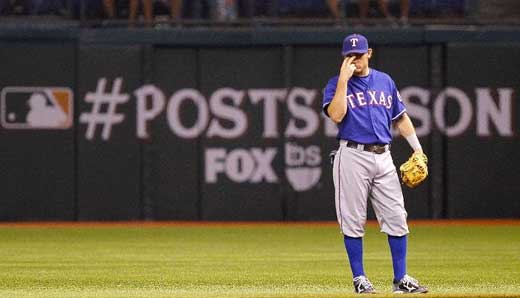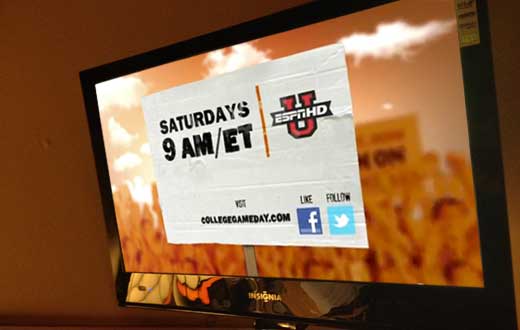One of the best ads on television that I feel does a pretty job of promoting their social outlets is “Ask Me” ads from Tempur-Pedic. The whole idea behind this television ad, do not take Tempur-Pedic’s word for it…ask the community about their products. As you watch, you will see the ad challenging you to ask your friends on Facebook and Twitter about their products…encouraging the community to speak.
As we look around on television, we are starting to see more and more organizations promote their social outlets. Even during the MLB Postseason play, you can see a Twitter hashtag in the background (#POSTSEASON)…encouaging people to use this hashtag when on Twitter talking about postseason play.
We are also seeing many television ads adding the social icons at the end of the spot. If you see below, ESPN’s College Gameday is promoting their website, Twitter, and Facebook channels.
So I have a few questions about this trend…I will use this College Gameday television spot as a part of this analysis. So if you look at this add, this is the last 5 seconds of the 30 second spot. It is asking you to do a few things:
1) Tune in on Saturday’s at 9am
2) Visit the CollegeGameday.com website
3) “Like” their Facebook Page
4) “Follow” their Twitter account
So, let me ask this…how do I find the Facebook page or Twitter account for College Gameday? I guess I can go to the website CollegeGameday.com and it will give me a place to click the link to the Facebook and Twitter accounts. But, we are forcing people to search to find this information…don’t we want to make this as easy as possible. Why can’t they give me the exact URL to these accounts so I can find these outlets faster?
But here is my bigger question…these are a lot of options to choose from in the last five seconds: tune in, visit the website, Like, and Follow. Ok, which one do I do? I guess I pick the one that is right for me, maybe? This is the same as having all those social outlet buttons on a blog post, so many to choose and not sure which one?
Back to my question, a lot of options to choose from in a short amount of time (5 seconds to be exact). I am sorry, we live in a DVR/YouTube age to rewind. But, as a user or social consumer of information, which outlet is going to give me what? Plainly put, what is difference between each outlet? What is different from the Facebook page that is any better/less important that the Twitter account. Also, why should I go to the website? Which one should I choose and why?
As I look through each online outlet (website, Facebook, and Twitter), I am starting to see some interesting things.
1) The website basically informs the audience where College Gameday will be hosting their show each week during the football season. They also are pulling in their Facebook and Twitter feeds into one spot halfway down the page, below a lot of video content.
2) The Twitter account is a social outlet just for the ESPN Analyst. ESPN is not engaging with their community, they are sharing/chatting/updating between their own sponsored Twitter accounts, yet not engaging with the college football fan community. ESPN is pushing their community as a marketing engine, informing the public of their thoughts and opinions. The @CollegeGameday Twitter account has close to 138,000 followers.
3) The Facebook page is a place to share rich media, specifically video and photos from the weekly stops along with top college football news. Each Facebook post has LOTS of comments from the fans, engaging in conversation about the posted topic. The College Gameday Fan Page has close to 714,000 “Likes” or fans.
So, why am I addressing this issue.
1) Why are we burying social outlets in the last five seconds of a television spot?
2) Why are we not providing direct URL’s for the audience to find these social outlets?
3) Why are we sharing to many outlets to choose from…instead of focusing out marketing efforts on one outlet and what the community will get from this specific outlet?
I want to see these ads explaining to me why should I go find your Facebook page or Twitter account. Why should I take the time and what will I get from this social experience. ESPN does a good job of coming up with creative television spots promoting a topic, show, or initiative. You would think they could show us why to engage in their Facebook page or Twitter account.
We can do so much more than just bury a bunch of social outlet logos at the end of a television spot . We can give our audiences a reason to engage with a community, this might give them more of a reason to search for our social outlet and join our/their conversations.
Here is one of the ESPN College Gameday spots for your enjoyment:
Do you have any examples that you have seen where television ads are putting social channel icons at the end of the spots? I would love to know what you have found or noticed!






